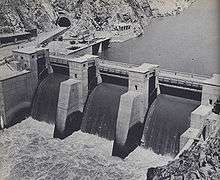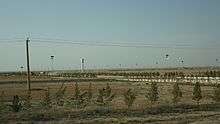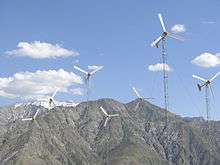Energy in Afghanistan

Energy in Afghanistan describes energy and electricity production, consumption, import and export in Afghanistan. Energy policy of Afghanistan describes the politics of Afghanistan related to energy more in detail.
Energy in Afghanistan is primarily provided by hydropower. Two decades of warfare have left the country's power grid badly damaged. As of 2012, approximately 33% of Afghan population has access to electricity and in the capital Kabul, 70% have access to reliable 24hr electricity. Afghanistan generates around 600 megawatts (MW) of electricity mainly from hydropower followed by fossil fuel and solar. Officials from Da Afghanistan Breshna Sherkat (DABS) estimate that the country will need around 3,000 MW to meet its needs by 2020.[1] The Afghan National Development Strategy has identified alternative energy, such as wind and solar energy, as a high value power source to develop. Alternative energy projects are already being tested across the country, from wind turbines in Panjshir Province to micro hydro dams in Badakhshan, to family-size biogas digesters throughout the country.
Hydroelectricity

Hydroelectric plants were built between the 1950s and the mid-1970s, which included the Sarobi hydroelectric power plant in Kabul Province, the Naghlu in the eastern Nangarhar Province, the Kajaki in Helmand Province and a number of others. Other hydroelectric facilities that were operational as of 2002 included plants at Puli Khumri, Darunta in Nangarhar Province, Dahla in Kandahar Province, and one in Mazar-i-Sharif. Also in operation was the Breshna-Kot Dam in Nangarhar, which had a generating capacity of 11.5 MW. Construction of two more power stations, with a combined capacity of 600 kW, was planned in Charikar City.
The southern region of Afghanistan is lacking adequate electricity due to problems with the Kajaki power plant in Helmand, which has been damaged and neglected for many years.[2] A third generating turbine is being added with the assistance of the United States Agency for International Development (USAID).[3] This will add 16.5 MW to its generating capacity and eventually provide the southern Afghan cities of Kandahar and Lashkar Gah with 24-hour electricity once the Kajaki project is completed. A number of other water mega dams are being built in different parts of the country, which are mainly for irrigation purposes. Two new dams are under construction in Kunar Province, one of which has the capacity of 1500 MW in Surtak area of the subjected province.[4][5]
Natural gas and oil
Natural gas was Afghanistan's only economically significant export in 1995, going mainly to Uzbekistan via pipeline. Natural gas reserves were once estimated at 140 billion cubic metres. Production started in 1967 with 342 million cu m but had risen to 2.6 billion cubic metres by 1995. In 1991, a new gas field was discovered in Chekhcha, Jowzjan Province. Natural gas was also produced at Sheberghan and Sar-e Pol. As of 2002, other operational gas fields were located at Djarquduk, Khowaja Gogerdak, and Yatimtaq, all in Jowzjan Province. In 2002, natural gas production was 1.77 billion cubic feet.
In August 1996, a multinational consortium agreed to construct a 1,430 km pipeline through Afghanistan to carry natural gas from Turkmenistan to Pakistan, at a cost of about $2 billion. However, US air strikes led to cancellation of the project in 1998, and financing of such a project has remained an issue because of high political risk and security concerns. As of 2012, the leaders of four countries had signed an agreement to build the Turkmenistan-Afghanistan-Pakistan-India (TAPI) pipeline.[6]
A very small amount of crude oil is produced at the Angot field in the northern Sar-e Pol Province. Another small oilfield at Zomrad Sai near Sheberghan was reportedly undergoing repairs in mid-2001. Petroleum products such as diesel, gasoline, and jet fuel are imported, mainly from Pakistan and Central Asia nations. A small storage and distribution facility exists in Jalalabad on the highway between Kabul and Peshawar, Pakistan.
Afghanistan is reported to have oil reserves totaling 2.9 billion barrels.
Electricity import
Uzbekistan
Discussions on electricity supplies began back in 2006, the Construction of a 442-kilometre (275 mi) high voltage transmission line from Uzbekistan to Afghanistan was completed by October 2008. It runs from Kabul through five Afghan provinces towards the country's border with Uzbekistan, and connects to the Uzbek electricity transmission system. It is expected the project will cost $198 million [USD] the transmission lines were jointly funded by India and the Asian Development Bank.[7] As a result, by early April 2009, all of Kabul all of the capital city of kabul had 24-hour electricity, the increase in power has already made a difference to many ordinary Afghans. By 2011, the 220 kV line form Uzbekistan had a capacity of nearly 300 MW.[8]
Coal
Afghanistan is reported to have coal reserves totalling 100-400 million tons. These mines are located from Badakhshan and extend up to Herat Province. Afghanistan has more than 11 coal reserves which include
Bamyan province
- Ashposhta and Sarasia coal reserves - 150 million tons
- Sarjungel and Sar Asia coal reserves
Baghlan province
- Karkar coal reserves
- Dodkash coal reserves
Samangan province
- Dara e sof-Shabashak reserves (Very High Quality) 74 million tons
- Darae e sof- Gola badri - Keshine Mabayen Village and Balkhab District coal reserves
Badakhshan province
- Kotal khaki - Barf District coal reserves
Parwan province
- Farakort Gorband Province and Gawoparan Surkhparsa District coal reserves
Herat province
- Karukh coal reserves - 15 million tons
Daikundi province
- Lagharjoe - Kacharan District coal reserves
Uruzgan province
- Kandalan Village Mudakhil District coal reserves
loay paktia
khost and paktia coal reserves - 75 million ton
Solar

In 1991, a new 72-collector solar installation was completed in Kabul at a cost of $364 million. The installation heated 40,000 liters of water to an average temperature of 60 °C around the clock. The use of solar power is becoming widespread in Afghanistan.[9][10][11] Solar-powered street lights are seen in several Afghan cities and towns, including the capital Kabul. Many villagers in rural parts of the country are also buying solar panels and using them.
Geothermal
An area of vast untapped potential lies in the heat energy locked inside the earth in the form of magma or dry, hot rocks. Geothermal energy for electricity generation has been used worldwide for nearly 100 years. The technology currently exists to provide low-cost electricity from Afghanistan’s geothermal resources, which are located in the main axis areas of the Hindu Kush. These run along the Herat fault system, all the way from Herat to the Wakhan corridor in the North.
With efficient use of the natural resources already abundantly available in Afghanistan, alternative energy sources could be directed into industrial use, supply the energy needs of the nation and build economic self-sufficiency.
Uranium
The Helmand Province in southern Afghanistan has uranium reserves, confirmed by Afghan Ministry of Mines.[12][13]
Biogas
Besides wind and sun, potential alternative energy sources for Afghanistan include biogas and geothermal energy. Biogas plants are fuelled by animal dung, and produce a clean, odourless and smokeless fuel. The digestion process also creates a high-quality fertilizer which can benefit the family farm.
Family-sized biogas plants require 50 kilograms of manure per day to support the average family. Four to six cows are required to produce this amount of manure, or eight to nine camels, or 50 sheep/goats. Theoretically, Afghanistan has the potential to produce about 1,400 million cubic meters of biogas annually. A quarter of this amount could meet half of Afghanistan’s energy needs, according to a January 2011 report from the United States National Renewable Energy Laboratory.
Wind

At least one wind farm was successfully completed in Panjshir Province in 2008, which has the potential to produce 100 kW of energy.[14] United States Agency for International Development has teamed up with the United States National Renewable Energy Laboratory to develop a wind map of Herat province. They have identified approximately 158,000 megawatts of untapped potential wind energy. Installing wind turbine farms in Herat could provide electricity to much of western Afghanistan.[15] Smaller projects are wind pumps that already have been attached to water wells in several Herat villages, along with reservoirs for storing up to 15 cubic meters of water.
See also
References
- ↑ Electricity only reaches one in three Afghans. Reuters Jan. 2012
- ↑ "Re-Engineering Afghanistan: The coalition has spent hundreds of millions trying to give Afghanistan electricity. Unfortunately, it made many of the mistakes it made in Iraq," by Glenn Zorpette, IEEE Spectrum, October 2011
- ↑ Jean MacKenzie. "Watershed of Waste: Afghanistan's Kajaki Dam and USAID". GlobalPost. Retrieved 22 April 2016.
- ↑ "Joint dam on Kunar River being mulled". Retrieved 22 April 2016.
- ↑ http://www.pajhwok.com/en/2013/04/10/energy-master-plan-being-implemented
- ↑ "Turkmenistan takes TAPI on the road". UPI. 30 July 2012. Retrieved 22 April 2016.
- ↑ "Electricity Supply in Afghanistan". Retrieved 22 April 2016.
- ↑ http://centralasiaonline.com/cocoon/caii/xhtml/en_GB/features/caii/features/2008/07/07/feature-02
- ↑ Seattle Engineer Brings Solar Power To Afghanistan
- ↑ John G Johnston (19 January 2011). "Solar Just For Greenies? Nope, US Army Using Solar In Afghanistan". Retrieved 22 April 2016.
- ↑ "Home - Afghan Solar". Retrieved 22 April 2016.
- ↑ Afghanistan sitting on a gold mine
- ↑ "defpro.com". Retrieved 22 April 2016.
- ↑ 'Green' Energy Demonstrates Progress in Afghan Province
- ↑ http://sada-e-azadi.net/Joomla/index.php/en/topics/features/6714-energy-that-never-run-out
External links
| Wikimedia Commons has media related to Energy in Afghanistan. |
- Afghanistan Inter-ministerial Commission for Energy
- Energy profil in afghanistan
- Afghanistan: Natural Resources and Energy
- Energy data of afghanistan